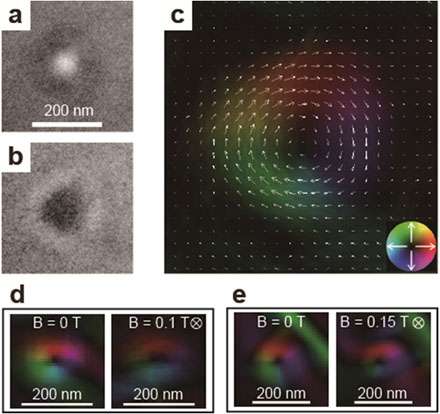Observation of skyrmions in a ferromagnet with centrosymmetry

Researchers from the National Institute of Materials Science (NIMS) have used Lorentz electron microscopy to show that magnetic skyrmions are spontaneously formed as nanomagnetic clusters in a ferromagnetic manganese oxide with centrosymmetry.
The recently discovered magnetic vortex structures known as magnetic skyrmions have been shown to have very interesting and unprecedented properties, such as a very great anomalous Hall effect and skyrmion motion under ultra-low-density currents. They have raised hopes of their application as new magnetic elements. The formation of skyrmions is thought to require the application of a magnetic field to a magnet that does not have centrosymmetry.
However, it has now been shown for the first time by direct observation with Lorentz electron microscopy that nanomagnetic clusters spontaneously form skyrmion structures even in ferromagnetic manganese oxides where the crystal structures have centrosymmetry. This result suggests the possibility that skyrmion structures might be formed even in nanomagnetic clusters and nanoparticles of various ferromagnets that do not meet the conditions conventionally deemed necessary.
The skyrmions observed in this research indicate a phenomenon in which the magnetic vortex repeatedly inverts between clockwise and counterclockwise at a certain temperature because of thermal fluctuation. It was also found, moreover, that when two skyrmions come close together, they invert to the same vortex direction in synch with each other. This result would seem to provide new knowledge for the development of magnetic elements using the interaction between skyrmions.
The result also points to a method of determining the energy needed for inverting the magnetic vortex of individual nanomagnetic clusters by Lorentz electron microscope observation. This method could potentially be applied widely with nanomagnets and nanomagnetic devices for which it is difficult to determine the energy required for magnetic inversion by ordinary measurement.
The findings were announced in the advance online edition of the British scientific journal Nature Nanotechnology on April 29, 2013.
Journal information: Nature Nanotechnology
Provided by National Institute for Materials Science




















